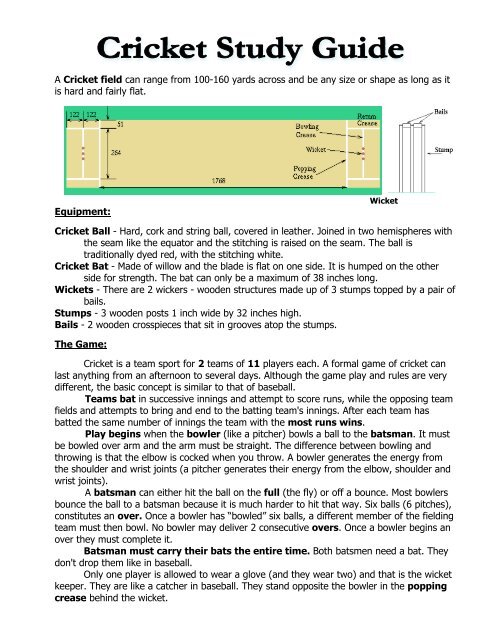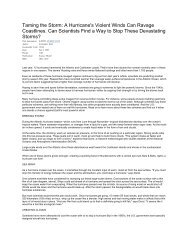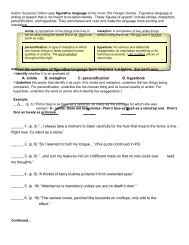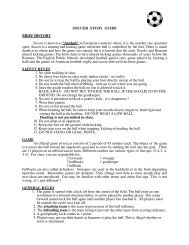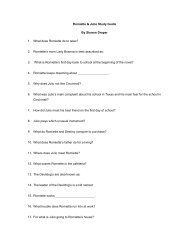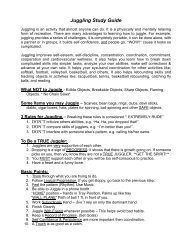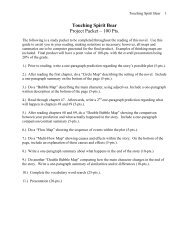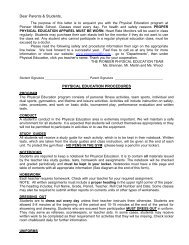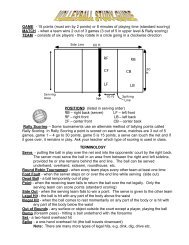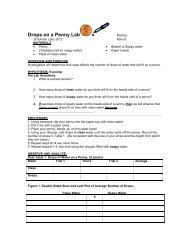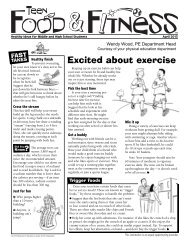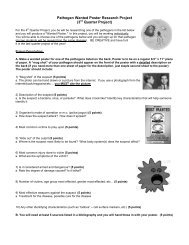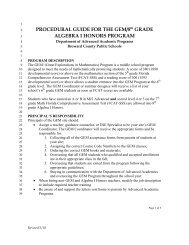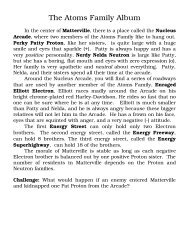Create successful ePaper yourself
Turn your PDF publications into a flip-book with our unique Google optimized e-Paper software.
A <strong>Cricket</strong> field can range from 100-160 yards across and be any size or shape as long as it<br />
is hard and fairly flat.<br />
Equipment:<br />
Wicket<br />
<strong>Cricket</strong> Ball - Hard, cork and string ball, covered in leather. Joined in two hemispheres with<br />
the seam like the equator and the stitching is raised on the seam. The ball is<br />
traditionally dyed red, with the stitching white.<br />
<strong>Cricket</strong> Bat - Made of willow and the blade is flat on one side. It is humped on the other<br />
side for strength. The bat can only be a maximum of 38 inches long.<br />
Wickets - There are 2 wickers - wooden structures made up of 3 stumps topped by a pair of<br />
bails.<br />
Stumps - 3 wooden posts 1 inch wide by 32 inches high.<br />
Bails - 2 wooden crosspieces that sit in grooves atop the stumps.<br />
The Game:<br />
<strong>Cricket</strong> is a team sport for 2 teams of 11 players each. A formal game of cricket can<br />
last anything from an afternoon to several days. Although the game play and rules are very<br />
different, the basic concept is similar to that of baseball.<br />
Teams bat in successive innings and attempt to score runs, while the opposing team<br />
fields and attempts to bring and end to the batting team's innings. After each team has<br />
batted the same number of innings the team with the most runs wins.<br />
Play begins when the bowler (like a pitcher) bowls a ball to the batsman. It must<br />
be bowled over arm and the arm must be straight. The difference between bowling and<br />
throwing is that the elbow is cocked when you throw. A bowler generates the energy from<br />
the shoulder and wrist joints (a pitcher generates their energy from the elbow, shoulder and<br />
wrist joints).<br />
A batsman can either hit the ball on the full (the fly) or off a bounce. Most bowlers<br />
bounce the ball to a batsman because it is much harder to hit that way. Six balls (6 pitches),<br />
constitutes an over. Once a bowler has “bowled” six balls, a different member of the fielding<br />
team must then bowl. No bowler may deliver 2 consecutive overs. Once a bowler begins an<br />
over they must complete it.<br />
Batsman must carry their bats the entire time. Both batsmen need a bat. They<br />
don't drop them like in baseball.<br />
Only one player is allowed to wear a glove (and they wear two) and that is the wicket<br />
keeper. They are like a catcher in baseball. They stand opposite the bowler in the popping<br />
crease behind the wicket.
Scoring:<br />
* If a batsman hits the ball on the full, the length of the field they score 6 runs (a homerun).<br />
* If a batsman hits the ball on the ground and it leaves the length of the field they get 4<br />
runs.<br />
* If a fielder catches the ball and they run off the field the batter gets 6 if on the full or 4 if<br />
on the ground.<br />
* If an over throw occurs and the ball leaves the field 4 runs are scored for the batting team.<br />
* If, while running multiple runs, a batsman does not touch the ground beyond the crease<br />
before they go to the next run, the umpire will rule one short and reduce the score by<br />
one run.<br />
10 Ways to Get Out:<br />
Caught: Fielder catches the ball on the full (fly). However, if the fielder catches the ball and<br />
during the catch steps on or over the boundary it results in 6 runs from the batsman<br />
and they aren’t out.<br />
Bowled: Batsman misses the ball and the ball breaks the wicket (like a strikeout).<br />
Leg Before Wicket: If the batsman misses the ball with the bat, but intercepts it with part<br />
of their body when it would have otherwise hit the wicket. Umpires decision is needed.<br />
Stumped: Batsman misses the ball and in attempting to run, or return to the crease and a<br />
fielder breaks the wicket before they can get grounded behind the crease.<br />
Run Out: If the batsman is attempting to take a run, or return to the crease and a fielder<br />
breaks the wicket before they can get grounded behind the crease.<br />
Hit Wicket: When a batsman breaks the wicket himself (usually with the bat).<br />
Handle the Ball: If the batsman touches the ball in the field of play.<br />
Obstructing the field: When the batsman interferes with a fielder trying to gather the ball.<br />
Hit the ball Twice: Hitting the ball a 2 nd time for any reason.<br />
Timed out: If a new batsman takes longer than 2 minutes to get into the crease.<br />
Officials: There are 2 umpires in a cricket game. They stand in each popping crease.<br />
For more information about the game of <strong>Cricket</strong>, check the website below or Google<br />
“<strong>Cricket</strong> Game”. Good luck!<br />
www.cs.purdue.edu/homes/hosking/cricket/explanation.htm


